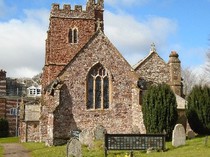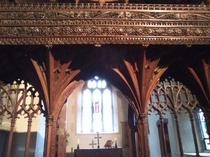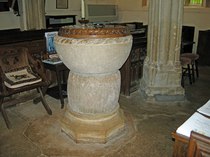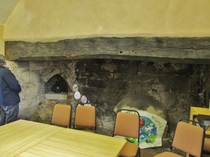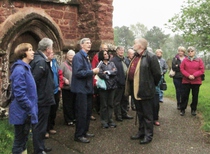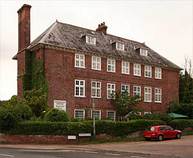
PARTS OF PINHOE
A SHORT HISTORY
Visit and walk on 12 May 2016
In pouring rain, eighteen of us ran into the St Michael and all Angels Church and were made welcome by Malcolm, our Programme Organiser, and John, a Church Warden who had generously given up his morning to open the church for us.
Macolm explained that there had probably been a Saxon wooden church on this site with a much needed tower at its west end, undoubtedly built in timber, wattle and daub.
In 1001 AD the church tower lookout warned that the Danes were approaching. The locals collected at the church and, when they realised they had insufficient arrows, the local vicar risked his life to trot on a donkey through the Danish lines to Exeter to collect more arrows. Records show that he was rewarded with an annuity of 1 mark from the King (Ethelred the Unready). This is still paid annually; it amounts now to 80 pence.
The Danes nevertheless won the battle and looted and destroyed the church and Pinhoe village before going on to do the same in Broadclyst (then called Cliston). The names Pinhoe and Cliston both reflect the names of local streams or rivers, the Pin Brook and the River Clyst.
Because the lower land was swampy and the Pin Brook would flood, the village and church were sited up the hill. Over the years the swamp cleared, so the villagers relocated down the hill; the church is now all alone at the top of the hill, even the vestry is now located down the hill near the Pinbrook shops.
The present church building started with the Main Nave constructed in the early 1400s. The North Aisle was added in the 16th century. By the late nineteenth century the building was in a very poor state and repair work was essential. The chancel, the nave, the aisle and the tower were rebuilt and a secret staircase leading to the rood loft was discovered. The Rood is the name given to the statue of Christ on the Cross at the entrance to the Chancel sanctuary. The original was destroyed in the 17th century when Devon became one of the most puritan counties in England! The present rood was made by Herbert Reed of Exeter in 1962.
The font is the church’s oldest feature. The base is thought to be Saxon and may well have stood in the original Saxon wooden church. When, during the nineteenth century restoration the font was cleaned, Norman markings were seen for the first time. These are so-called “bat marks” - the rope pattern of Norman builders.
The pulpit is at least as old as the rood screen, and possibly older. It appears to have been altered at the end of the 16th century because it shows the arms of Bishop Cotton who oversaw this church @ 1600. Also, the arms of the Bamfylde family painted over figures of saints were revealed as recently as 1996.
Church wardens were charged with collecting money and putting it in the poor man’s box. This unique statuette is one of only two in the country and shows a parish beadle in the time of Queen Anne. John, the current church warden, told us how the box was once stolen and found, luckily, in a rubbish dump. The box was worth far more than the stolen money!
Outside is the old vicarage which is now a private dwelling. An earlier vicarage built in 1703 was destroyed by a hurricane and this Queen Anne style one built to replace it. At the back is a huge chimney stack connecting it to the only part of the original building which survived the hurricane. During recent work on this back section an incredible large fireplace was revealed which has been lovingly preserved.
The low thatched roof on the rare Lych Gate dates from 1620 and means there is no access for a funeral limousine. So coffins have to be carried in and undertakers cannot carry a coffin under it on their shoulders. A special purpose-built Bier Cart, a hand-carriage, was used and still exists on permanent loan to the Implements and Equipment Museum at Bickleigh Park.
St Michael has been the patron saint of sailors and fishermen so churches named St Michael are nearly always built on a high point to provide a good landmark for a ship’s return to harbour. That is why the church was once covered in white painted rough cast to make it visible from a distance and t he rough cast was removed during the restoration when Victorian advances in technology meant that it was no longer needed.
We took an ancient path down the hill and arrived at Pinbrook House, built in the Queen Anne style in 1679. It was the principal dwelling of a large farm, Pinbrook Farm. There are some blocked-up windows, a probable reminder of the very unpopular window tax in 1696. We admired the stone flagged floor and the great fireplace in the main reception room as well as the turning staircase which had no central support – an unusual feature in the 17th century.
We ended our visit by crossing the Pin Brook and admiring Heath Barton House, a most attractive thatched building. It was once the farmhouse of land now known as Eastern Fields which is owned by the Council and maintained as a most attractive quasi-woodland. We saw a wonderful 1921 photograph of people covering the whole of Eastern Fields and neighbouring Exhibition Fields - having come to watch aeroplanes landing from Bristol as part of a round Britain air race.
Thus ended our trip round the western side of Pinhoe.
